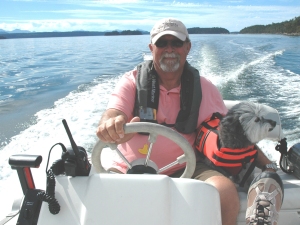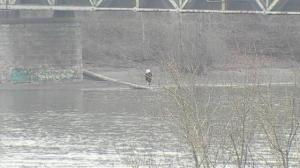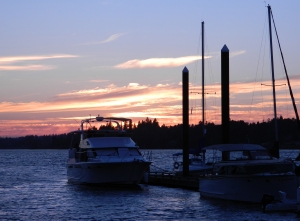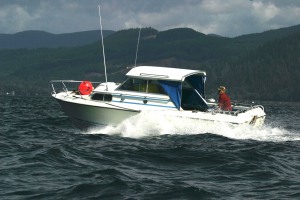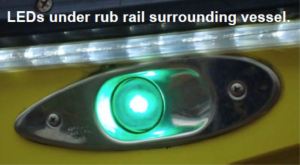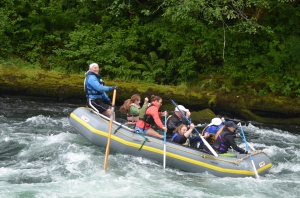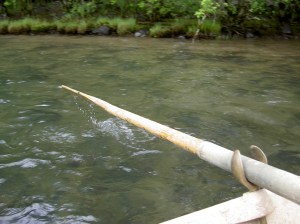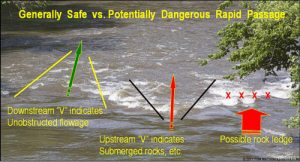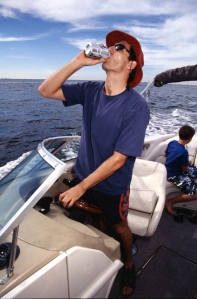-by Ken Tennefoss, Cruising Boat Oregon Advisory Team Member
We spent eleven days cruising the lower Columbia River from Portland to Astoria in our boat this summer. What a wonderful time we had! It is a trip we have made several times, and is one of our favorites. I can’t think of too many other things I would rather be doing than sitting at the helm of Mucho Gusto on a summer day, motoring along one of the largest rivers in North America.
We are so fortunate to live in a state with such abundant recreational areas and variety of waterways. Although the river levels were low, we were still able to find plenty of areas to anchor and play in with our water toys. The fishing was good and the weather, for the most part, cooperated.
We began our trip by heading down-stream from Portland on the Multnomah Channel. We had only gone a couple of miles before we saw our first bald eagle, one of several we saw on our trip. The salmon were running, so there were quite a few boats on the channel all plying for the “catch of the day.” While we had to make course changes a few times to avoid getting too close to anglers, the cruise to St. Helens was uneventful and along the way we were able to watch a couple of anglers catch bright chinook salmon.
Over the first few days, we anchored with a few other boats in a peaceful backwater cove off the Columbia River, near Goble. The water was warm and the company was fun. One of the highlights is a quick dingy ride to the Goble store for an ice cream treat.
Our next destination was to the waters behind Lord and Walker Islands, just a mile or so downstream from Rainier. It’s a favorite spot for both water skiers and cruisers but on one particularly calm morning, I took some memorable pictures of a skier cutting across the mirror-like surface in the early morning sunrise. Waterskiers seek out flatwater in back island areas that are protected from the wind and wave chop.
Our next run down-stream was longer, cruising toward Cathlamet Bay, behind Tongue Point. We anchored just in time to view a spectacular blazing sky of reds and pinks as the sun dipped behind the hills above Astoria. The next day, we explored the tidal flats which are a labyrinth of small channels and back waters that are ideal for exploring in a kayak or small boat. It’s easy to feel like Lewis and Clark, wondering what lies around the next turn.
I admit I sometimes take for granted this great recreation resource and forget that without proper management and funding, it could easily be lost. Oregon is fortunate to have a single agency that regulates the waterways and also works with facility providers to ensure there’s boating access to the variety of waterways in the state. Oregon’s State Marine Board is funded by boat title and registration fees and according to the agency’s web site, it’s mission is “Serving Oregon’s recreational boating public through education, enforcement, access, and environmental stewardship for a safe and enjoyable experience.” I’ve come to recognize as a member of one of the Marine Board’s advisory teams, that boaters need to help by giving the Board feedback on our likes and dislikes, so they can continue to provide services and keep making Oregon a great place to play. I encourage all users of our waters to let the OSMB know what they are doing right, as well as your thoughts on how they can make improvements. That way, generations to come will have an opportunity to enjoy Oregon’s lakes, rivers, bays and ocean.
By the way, if you want to share your thoughts or experiences on boating in Oregon, this OSMB blog is a great place to do that. It’s also a great place to go to read other people’s input. If you’re not sure where to go or where to put in, the Marine Board has an interactive map on their website that shows where all the boat ramps are in the state. This is a great place to start planning your summer adventures.
-Ken Tennefoss
For more information about the Marine Board and to find a boat ramp near you, visit http://www.boatoregon.com.
